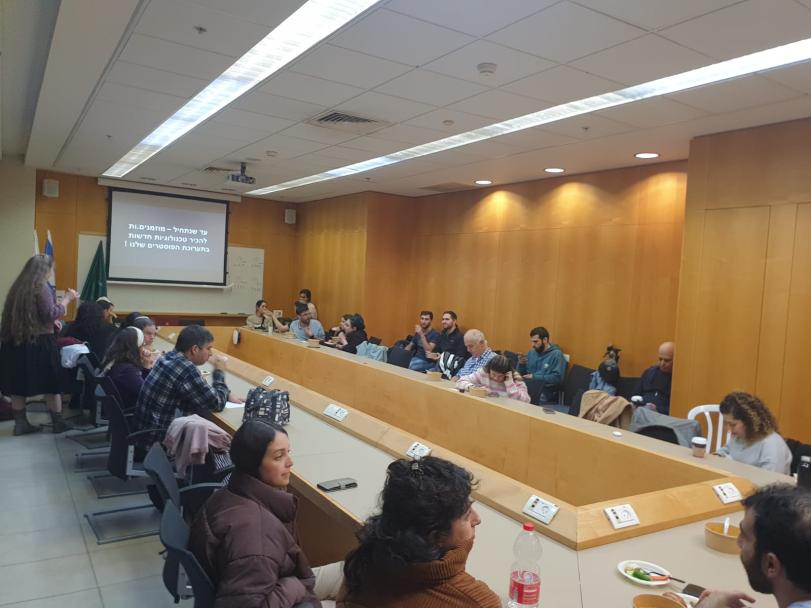Know, try, love

The Brainstorm community event held last month at the Faculty of Engineering provided students with opportunities to experiment with advanced neuroscience technologies, including VR and expansion sequencing
Late last month, the Faculty of Engineering hosted Brainstorm Bar-Ilan’s "Meet the Tech" event. “It was a great success, very versatile, and exposed participants to technologies and the different labs that operate at our faculty and the Brain Research Center. Attendees networked and connected, and expressed ample interest and active participation in the different stations,” shares Michal Danino Levi, one of the event’s organizers, a PhD student at Dr. Shahar Alon’s lab, and representative of the Brainstorm Community at the Faculty of Engineering. “We are grateful to the Faculty of Engineering for all their help and support of this event.”
Brainstorm is a students’ neuro-tech that operates in several universities in Israel, among which is Bar-Ilan. Its goal is to create a national community of parties interested in brain research, generate interaction and collaborations between academia and the industry and between students, and promote entrepreneurship and innovation. “Originally, Brainstorm formed at the Interdisciplinary Brain Research Center, so students from other faculties, like the Faculty of Engineering, may have felt out of place. But I want to stress that it welcomes anyone who has any sort of interest in neuroscience, even without any prior knowledge. Our community today has students from engineering, brain science, computer science, life science, physics, psychology, and education,” Danino Levi clarifies. “The community is very much a family, we’re very supportive, the atmosphere is friendly, we promote shared discourse among students, and we make sure to leave time for mingling because getting to know one another and forming collaborations is so important.”
The community at Bar-Ilan has been active for several years and holds monthly events for Bar-Ilan students on a national scale. Over the years there have been panels of academics and industry leaders who offered tools for success in the field; round table discussions designed to help students market their skills, introduce them to platforms such as LinkedIn, and self-realization and interview prep workshops; and course, an annual hackathon. This year’s opening event was a "FuckUp Night" in which four keynote speakers from Bar-Ilan University shared their failures and how they used those to pave a path to success.
The latest event, Meet the Tech, was a collaboration between the community and the Faculty of Engineering designed to expose students to advanced brain science technologies in a hands-on environment. “We had four stations, each presenting technology from a different field, and the students got to experiment with it and see how it works, what it looks like, and what results they can expect,” shares Danino Levi. “The event also included poster displays of other technologies from the Faculty of Engineering and Brain Research.”
Students got to experience these four stations:
VR station: Using virtual reality to understand brain functions. Researchers at Dr. Yaara Erez’s lab at the Faculty of Engineering study the organization of brain networks involved in different functions. Alongside using a variety of systems to measure signals of brain activity, virtual reality is used in the lab to study cognitive functions such as information processing and attention in as natural an environment as possible that simulates how people operate in real life. This method enables a deeper understanding of different functions by allowing the use of more precise mathematical models to understand information processing in the brain, and aids in the development of suitable tools for preserving and rehabilitating functionality affected by various diseases.
Expansion sequencing station: An innovative technology developed in Dr. Shahar Alon’s lab at the Faculty of Engineering enables spatial RNA sequencing through the physical expansion of the tissue. This technology lets researchers ask broad questions relating to gene expression. For example, one can study the genes affiliated with interactions between immune system cells and cancerous cells. The station offered students the opportunity to experiment with creating gels that inflate tissue, view sequencing results under a microscope, and learn more about the method.
Open BCI station: A technology that enables real-time reading of brain waves and transmitting and using them in hardware or software interfaces. Using this technology, users can convert information and control digital screens, robots, or any other digital device that receives data. OpenBCI is one of the most accessible BCI technologies available today; the software is free, and open source and the hardware is subsidized. What makes it so unique is that it connects, via a very simple interface, to Arduino, open-source hardware with an extensive collection of libraries for operating sensors and motors.
EMOTIV station: The EMOTIV system measures electric brain activity in a manner similar to EEG, but its key advantage lies in its mobility: it is a wireless helmet with a user-friendly interface designed to be used not only by the scientific community but by the general public as well. Users can learn how to operate it in just minutes, even without prior experience. Researchers at Prof. Ilana Zion-Golembik use the EMOTIV helmet to study auditory attention in the real world—in high schools, several students at a time—something that would not have been possible otherwise. The helmet is also used in gaming, medicine, and rehabilitation.
The Brainstorm event was attended by 50 participants from various faculties at Bar-Ilan University, ranging from bachelor's students to faculty members. “The goal of this event is to get to know new technologies, and everyone can find something that interests them, no matter where they are in their academic career,” Danino Levi explains. “Our community welcomes everyone who finds brain research interesting; there are no fees and no commitments. We’re also very open to new ideas; if anyone wants to hold an event, on their own or as a collaboration, or maybe learn about a specific subject—we’re happy to hear from them.”
To learn more about the community and to join them, click here
Last Updated Date : 27/02/2023



